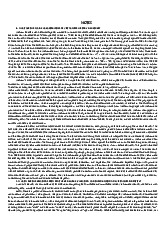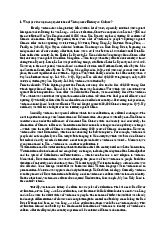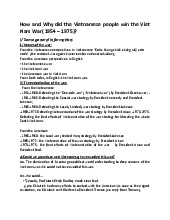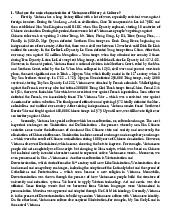



















Preview text:
lOMoAR cPSD| 58097008
Full Name: Tran Duc Huy/ Student ID: BTBTWE23031 A Journey Through Vietnamese History I/ Introduction
Vietnamese history is a tapestry woven with threads of resilience,
independence, and cultural richness. From ancient times to the modern
era, Vietnam has witnessed dynasties, colonial rule, wars, and
ultimately emerged as a sovereign nation. This narrative explores key
milestones in Vietnamese history, navigating through the ebbs and
flows that have shaped this Southeast Asian nation. II/ Ancient Vietnam Prehistoric Period
The prehistoric period of Vietnam is a chapter in the nation's history
that unfolds in the mists of time, revealing the early foundations of
human habitation and the emergence of distinct cultures.
Archaeological discoveries provide glimpses into the lives of ancient lOMoAR cPSD| 58097008
Vietnamese communities, showcasing their resourcefulness, creativity,
and gradual societal evolution.
1. Early Settlements and Dong Son Culture (c. 3000 BCE – 100 CE):
● Ancient Habitation: Archaeological evidence suggests that
humans inhabited the region as early as 3000 BCE. These early
communities engaged in fishing, hunting, and basic agriculture.
● Dong Son Culture: One of the defining periods of ancient
Vietnam, the Dong Son culture (c. 700 BCE – 100 CE), is noted
for its advanced bronze casting techniques. Elaborate bronze
drums, weapons, and other artifacts showcase the technological
prowess and artistic finesse of this society.
2. Cultural Practices and Agriculture:
● Bronze Age Advancements: The Dong Son period marked the
transition from the Neolithic to the Bronze Age. The mastery of
bronze metallurgy allowed for the creation of sophisticated tools,
weaponry, and symbolic artifacts. ● Agricultural
Practices: Ancient Vietnamese communities
gradually adopted agriculture, cultivating rice and other crops.
This shift in lifestyle contributed to the establishment of settled villages. lOMoAR cPSD| 58097008
3. Interaction and Trade: ● Neighboring
Civilizations: Vietnam's location facilitated
interactions with neighboring civilizations, including those in
China and Southeast Asia. These exchanges influenced cultural
practices and technological innovations.
● Maritime Trade: Proximity to the sea enabled maritime trade,
connecting Vietnamese communities with distant lands. This
early engagement laid the groundwork for future trade networks.
4. Spiritual Beliefs and Burial Practices:
● Spiritual Practices: The spiritual life of ancient Vietnamese
communities is reflected in artifacts depicting mythical creatures,
animals, and ritualistic scenes. Ancestor worship and animistic
beliefs were integral aspects of their spiritual worldview.
● Burial Customs: Archaeological sites reveal diverse burial
practices, ranging from simple interments to elaborate tombs.
Grave goods, such as pottery and tools, provide insights into the
belief systems and daily lives of these ancient people.
5. Challenges and Adaptations:
● Environmental Changes: Ancient Vietnam faced environmental
challenges, including climate fluctuations and sea level changes. lOMoAR cPSD| 58097008
Communities adapted to these conditions, demonstrating a deep
connection with the natural world.
● Cultural Diversity: The prehistoric period witnessed the
emergence of diverse cultural practices and linguistic variations
among different communities, setting the stage for the rich
tapestry of Vietnamese culture.
The prehistoric period lays the groundwork for the subsequent chapters
in Vietnamese history. It reveals the ingenuity of ancient communities,
their evolving socio-cultural dynamics, and the resilience that would
define Vietnam through the centuries. As we delve deeper into the
annals of time, the narrative unfolds, showcasing the intricate mosaic of Vietnam's past. Chinese Domination
The period of Chinese domination in ancient Vietnam stands as a
chapter of resilience, cultural amalgamation, and intermittent
resistance. For nearly a millennium, Vietnam experienced varying
degrees of Chinese influence and control, shaping its sociopolitical
landscape and leaving a lasting impact on its identity.
1. The First Chinese Domination (207 BCE – 39 CE): lOMoAR cPSD| 58097008
● Han Dynasty Influence: The formal incorporation of Vietnam into
the Han Empire in 111 BCE marked the beginning of Chinese
domination. The Han rulers sought to assimilate Vietnam into
their administrative system and Confucian ideals.
● Cultural Exchange: During this period, Chinese administrative
practices, Confucianism, and Chinese writing systems were
introduced. While these cultural influences left an indelible mark,
Vietnamese society maintained its distinctiveness.
2. The Trung Sisters' Rebellion (40–43 CE):
● Emergence of Resistance: The Trung Sisters, Trung Trac and
Trung Nhi, emerged as heroic figures leading a significant
rebellion against Chinese rule. Their uprising in 40 CE reflected
the Vietnamese people's yearning for independence and their
capacity to resist external domination.
● Brief Independence: The Trung Sisters briefly established an
independent state, but Chinese forces eventually reasserted
control. The sisters' defiance, however, remains a symbol of
Vietnamese resistance to foreign domination.
3. Periods of Autonomy and Further Chinese Rule: lOMoAR cPSD| 58097008
● Autonomous Kingdoms: Despite Chinese dominance, periods of
relative autonomy occurred when Vietnam was ruled by local
leaders appointed by the Chinese court. These leaders often
maintained a delicate balance between loyalty to China and the
preservation of Vietnamese identity.
● Triệu Đà's Revolt (542–547 CE): Triệu Đà, a Vietnamese military
leader, led a notable revolt against Chinese rule. Although
ultimately unsuccessful, his rebellion exemplified the persistent spirit of resistance.
4. The Second Chinese Domination (602–939 CE):
● Tang and Song Dynasties: The Tang and Song Dynasties
expanded Chinese influence, leading to the second period of
direct domination. Vietnamese rulers faced challenges in
balancing their allegiance to China while safeguarding their cultural distinctiveness.
● Dinh and Early Le Dynasties: Internal strife and regional leaders
eventually paved the way for Vietnamese rulers to assert more
autonomy. The establishment of the Dinh and Early Le
Dynasties in the 10th century signaled a turning point.
5. Legacy of Chinese Domination: lOMoAR cPSD| 58097008
● Cultural Synthesis: While Chinese domination left a profound
impact on Vietnamese culture, it also fostered a synthesis of
Chinese and indigenous elements. This cultural amalgamation
laid the groundwork for Vietnam's unique identity, combining
Confucian principles with local traditions.
● Language Evolution: Chinese characters influenced the
Vietnamese writing system, creating a unique script called Chữ
Nôm. This system, though largely replaced by the Latin-based
script today, reflects the historical interplay of cultures.
The era of Chinese domination shaped the course of Vietnamese
history, leaving a complex legacy of cultural exchange, resistance, and
resilience. As the Vietnamese people navigated the challenges of
foreign rule, they simultaneously forged their distinct identity, setting
the stage for the later periods of independence and self-determination. III/ Medieval Vietnam
Independence and Dynasties
In 939 CE, Ngo Quyen defeated the Chinese at the Battle of Bach Dang
River, establishing the first independent Vietnamese state. The Ly
Dynasty (1009–1225) followed, introducing Confucianism and lOMoAR cPSD| 58097008
fostering cultural growth. The Tran Dynasty (1225–1400) faced
external threats, including the Mongol invasions.
The Ming Occupation and Le Dynasty
The Ming occupation (1407–1427) was a dark chapter, but
Vietnamese hero Le Loi led a successful rebellion, establishing the Le
Dynasty. This period laid the foundation for Vietnam's later resistance against foreign powers. Early Modern Vietnam
Nguyen Lords and Trinh Lords
The 16th century witnessed internal conflicts between the Nguyen
Lords in the south and the Trinh Lords in the north. This division
weakened Vietnam, making it susceptible to external threats. French Colonialism
1. Roots of French Colonialism:
● Early Encounters: Initial French involvement in Vietnam centered
around trade and missionary activities during the 17th century.
However, it was in the 19th century that France sought to expand
its colonial empire in Southeast Asia. lOMoAR cPSD| 58097008
● Imperial Rivalries: The scramble for colonies among European
powers intensified in the 19th century. France's desire for
economic opportunities, resources, and geopolitical dominance in
Southeast Asia fueled its interest in Vietnam.
2. French Conquest and Cochinchina (1858–1887):
● Treaty of Saigon (1862): After a series of military campaigns, the
Treaty of Saigon in 1862 ceded three southern provinces to
France, forming the colony of Cochinchina. This marked the
beginning of formal French colonial rule in Vietnam.
● Expansion to Tonkin and Annam: Military conflicts continued,
leading to the French expansion into Tonkin (northern Vietnam)
and Annam (central Vietnam) by the late 1880s.
3. French Indochina (1887):
● Formation of French Indochina: The colonial territories of
Cochinchina, Tonkin, Annam, Laos, and Cambodia were unified
in 1887 to form French Indochina. Vietnam became an integral
part of this larger French colonial project.
● Economic Exploitation: The French exploited Vietnam's
resources, transforming the agrarian economy to serve their
interests. Plantations, mines, and infrastructure projects were
developed, but largely for the benefit of French investors. lOMoAR cPSD| 58097008
4. Cultural and Social Impact:
● Educational System: The French established a Western-style
education system, but access was limited, and it primarily served
the elite. This education system inadvertently fueled nationalist
sentiments as a new, Western-educated class emerged.
● Social Stratification: French colonial rule exacerbated existing
social hierarchies. The Vietnamese population was subject to
discriminatory policies, and the French favored the local elites
who collaborated with colonial authorities.
5. Resistance and Nationalism:
● Phan Boi Chau and Early Nationalism: Intellectuals like Phan Boi
Chau emerged, advocating for Vietnamese independence. Chau's
writings inspired a sense of national identity and the need for
resistance against colonial oppression.
● Nguyen Ai Quoc (Ho Chi Minh): The emergence of figures like
Nguyen Ai Quoc (later known as Ho Chi Minh) and the
establishment of the Vietnamese Nationalist Party (VNQDĐ)
reflected the growing momentum of the independence movement.
6. World War II and Japanese Occupation: lOMoAR cPSD| 58097008
● Japanese Occupation (1940–1945): During World War II, Japan
occupied Vietnam. The French Vichy regime continued to
administer some areas, while the Japanese directly ruled others.
This occupation intensified anti-colonial sentiments and fostered resistance movements.
7. First Indochina War (1946–1954):
● Return of the French: After World War II, the French sought to
reestablish control in Vietnam. This led to the First Indochina War
against the Viet Minh, a communist-led nationalist movement led by Ho Chi Minh.
● Dien Bien Phu and Geneva Accords: The decisive Battle of
Dien Bien Phu in 1954 resulted in French defeat. The Geneva
Accords divided Vietnam along the 17th parallel, with the North
under communist control and the South remaining under French influence.
The period of French colonialism left an enduring impact on Vietnam,
shaping its political landscape and fostering a deep-seated desire for
independence. The struggle against colonial rule laid the groundwork
for the subsequent Vietnam War and the reunification of the country,
marking a pivotal moment in Vietnamese history. lOMoAR cPSD| 58097008 IV/ Modern Vietnam
Japanese Occupation and World War II
During World War II, Japan occupied Vietnam. The anti-Japanese
resistance, led by the Viet Minh under Ho Chi Minh, laid the
groundwork for future struggles against foreign dominance. First Indochina War
The defeat of Japan in 1945 led to a power vacuum. The First Indochina
War (1946–1954) ensued, with the French trying to reassert control.
The Battle of Dien Bien Phu in 1954 marked a turning point, leading to
the Geneva Accords and the division of Vietnam. Vietnam War
The Vietnam War, spanning from the mid-20th century, is a complex
and deeply consequential conflict that shaped the destiny of Vietnam
and reverberated globally. Marked by political ideologies, foreign
interventions, and the resilience of the Vietnamese people, the war left
an indelible mark on the landscape of Southeast Asia and international relations.
1. Background and Origins:
● Division of Vietnam (1954): The Geneva Accords of 1954
divided Vietnam along the 17th parallel, creating North Vietnam, lOMoAR cPSD| 58097008
led by the communist government under Ho Chi Minh, and South
Vietnam, backed by anti-communist forces. lOMoAR cPSD| 58097008 ●
Ideological Divide: The Cold War context intensified the
ideological divide, with North Vietnam aligning with the Soviet
Union and China, while South Vietnam received support from the
United States and other Western allies.
2. Escalation and U.S. Involvement:
● Gulf of Tonkin Incident (1964): The alleged Gulf of Tonkin
incident prompted the U.S. Congress to pass the Gulf of Tonkin
Resolution, granting President Lyndon B. Johnson the authority
to use military force in Vietnam.
● Troop Escalation: The U.S. escalated its military involvement,
committing a substantial number of troops to support the South
Vietnamese government against the communist forces in the North.
3. Viet Cong and Guerrilla Warfare:
● Viet Cong Insurgency: The National Liberation Front (NLF),
commonly known as the Viet Cong, waged a guerrilla war in
South Vietnam. Employing hit-and-run tactics and blending with
the local population, they posed a formidable challenge to
conventional U.S. military strategies. lOMoAR cPSD| 58097008 ●
4. Tet Offensive (1968):
Turning Point: The Tet Offensive, a massive surprise attack by the
North Vietnamese and Viet Cong during the Tet holiday, surprised
U.S. and South Vietnamese forces. Though militarily
inconclusive, it marked a psychological turning point, eroding
support for the war in the United States. 5. Anti-War Movement:
● Protests and Dissent: The Vietnam War sparked a significant anti-
war movement in the U.S. and around the world. Protests,
marches, and cultural expressions of dissent characterized this
period, reflecting a growing disillusionment with the conflict.
6. End of U.S. Involvement (1973):
● Paris Peace Accords: The Paris Peace Accords in 1973 marked
the formal end of U.S. involvement in Vietnam. A cease-fire was
declared, and U.S. troops withdrew, leaving the South Vietnamese
government to face the ongoing conflict.
7. Fall of Saigon (1975):
● North Vietnamese Offensive: In 1975, North Vietnamese forces
launched a major offensive. The South Vietnamese government, lOMoAR cPSD| 58097008 ●
facing internal instability and a lack of U.S. support, eventually collapsed.
Reunification: The fall of Saigon on April 30, 1975, marked the
reunification of North and South Vietnam under communist rule.
The country was officially named the Socialist Republic of Vietnam.
8. Legacy and Aftermath:
● Human Cost: The Vietnam War had a devastating human cost,
with millions of lives lost and widespread destruction. The use of
chemical agents, like Agent Orange, left a legacy of health issues
for both Vietnamese and U.S. veterans.
● Impact on Vietnam: The war deeply impacted Vietnam's
infrastructure, economy, and social fabric. Reconstruction efforts
faced challenges, but the nation embarked on a path of recovery and development.
The Vietnam War remains a complex and contentious chapter in
history, stirring debates about foreign intervention, the morality of
warfare, and the lasting effects on the nations involved. It has left an lOMoAR cPSD| 58097008 ●
enduring legacy, influencing diplomatic strategies, shaping public
perceptions, and prompting reflection on the costs of armed conflict. Post-Vietnam War Era lOMoAR cPSD| 58097008
The post-Vietnam War era marked a period of significant challenges
and transformations for Vietnam. Emerging from a devastating conflict,
the nation faced the arduous tasks of rebuilding, reconciliation, and
charting a new course for its future. This era witnessed economic
reforms, social reconstruction, and efforts to heal the wounds of war,
ultimately shaping Vietnam into the dynamic nation it is today.
1. Reunification and Early Challenges:
● Socialist Republic of Vietnam (1976): With the reunification of
North and South Vietnam in 1975, the Socialist Republic of
Vietnam was officially established. Hanoi became the capital, and
the government embarked on the challenging task of integrating the two regions.
● Post-War Challenges: The country faced immediate challenges,
including the reconstruction of war-damaged infrastructure,
addressing economic disparities, and handling the reintegration of
war veterans into civilian life.
2. Socialist Economic Model and Challenges (1975–1986):
● Collectivization Efforts: In the years following reunification,
Vietnam pursued a socialist economic model, emphasizing lOMoAR cPSD| 58097008
collectivization and central planning. However, these efforts
faced numerous challenges and yielded mixed results.
● Economic Struggles: The country experienced economic
difficulties, including food shortages, low productivity, and
inefficiencies in state-run enterprises. These challenges prompted
a reassessment of economic policies.
3. Reforms (1986 Onward):
● Introduction of Đổi Mới: In 1986, the Vietnamese government,
under the leadership of doi moi (renovation) reforms. This
marked a shift toward a socialist-oriented market economy,
embracing elements of capitalism while maintaining the oneparty political system.
● Foreign Investment and Liberalization: Đổi Mới opened up the
economy to foreign investment, encouraged private
entrepreneurship, and allowed for greater market-oriented
decision-making. These reforms proved instrumental in
revitalizing Vietnam's economy.
4. Economic Growth and Global Integration:
● Economic Successes: The doi moi reforms led to remarkable
economic growth, transforming Vietnam from a war-torn nation lOMoAR cPSD| 58097008
to one of Southeast Asia's fastest-growing economies. Industries
such as manufacturing, services, and technology flourished.
● Global Integration: Vietnam actively pursued international
integration, entering into trade agreements and fostering
diplomatic relations worldwide. This global engagement played a
crucial role in the country's economic development.
5. Social and Cultural Developments:
● Education and Healthcare: Vietnam prioritized investments in
education and healthcare, leading to improvements in literacy
rates and healthcare outcomes. The government's focus on human
development contributed to an emerging middle class.
● Preservation of Culture: Despite modernization, Vietnam has
made concerted efforts to preserve its rich cultural heritage.
Traditional arts, literature, and customs continue to play a vital
role in shaping the nation's identity.
6. Reconciliation and Diplomacy:
● Normalization of Relations: In 1995, the United States and
Vietnam normalized diplomatic relations, a significant step
toward reconciliation. This facilitated trade, cultural exchange,
and cooperation on various fronts.



